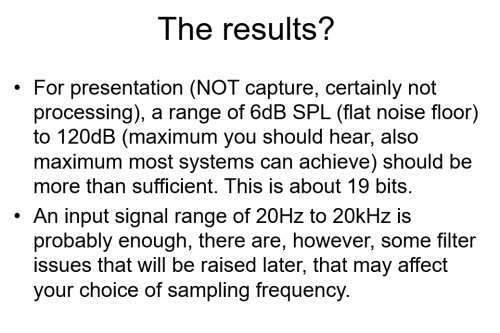I'm always keen to learn more about dither, ie how it eliminates quantasion errors and self dithering in analog devices (ie random noises introduced by errors in mechanical/transducer playback).
We can't avoid noise, but in digital audio we can choose what kind of noise we have. We can have quantization noise (no dither), reduced quantization noise (weak dithering) or no quantization noise at all (full dithering). The idea of dither is to have less harmful type of noise. The big problem with quantization noise is that it
correlates with the signal causing granulation. Dither noise breaks this correlation: We lose the correlation due to the added noise, but that's what we want. Weak dither just reduces correlation while adding just a little bit of dither noise in the signal. Some of the granulation remains, but it's perhaps not as harmful to sound quality. Increasing dither noise level removes the correlation completely, but at the cost of more dither noise added. The result is (noise free) signal + dither noise.
Now, here is the punch line:
Breaking the correlation between signal and noise makes it possible to store distortion-free signal levels below the least significant bit! This is among the counter-intuitive stuff that goes with digital audio and requires better understand of digital audio beyond the basic understanding. We can't increase signal to noise ratio. On the contrary using dither is about increasing noise level, but in audio technical signal to noise ratio doesn't tell everything. The spectral density of noise dictates, how harmful the noise is. Dithering is about being smart with the noise, make it as little as a problem as possible. Yes, we perhaps have dither noise, but the sound of piano attenuates below -96 dBFS levels (16 bit audio) undistorted into the noise and finally becames masked by the noise. That is, if you crank up the volume so much that you are able to hear signals this quiet. Dither noise shaping tries to optimize the spectral density of noise so that it's as inaudible as possible.
Analog sound with (enough) noise is self-dithered and will experience "clean" analog-to-digital transform, but we must live with the original noise level of course.
On another forum, a member there strongly argues that dither results in a loss of clarity, in addition to higher noise. While most of his posts do not make sense he does raise an interesting question. If the trade off with dither is just increased noise (ie tape hiss noise) then why wouldn't dithered 10 bits sound as distortion free as 24bits, just with more noise?
Dither is about adding noise to the signal, but if we for example use shaped dither, instead of having distorted signal with correlating quantization noise, we might have distortion-free signal with inaudible dither noise thanks to smart dither noise spectrum having most of the noise energy at frequencies our hearing is insensitive at.
Loss of clarity? Clarity defined as what? I wouldn't call use of dither properly loss of clarity.
In fact if we truncate and dither 24 bit audio to 10 bits, it IS as distortion free as the original but with "huge" noise.





